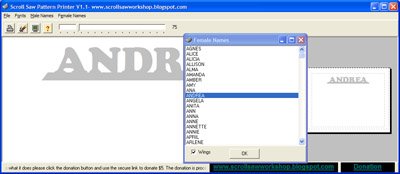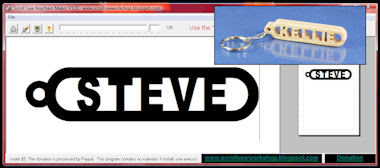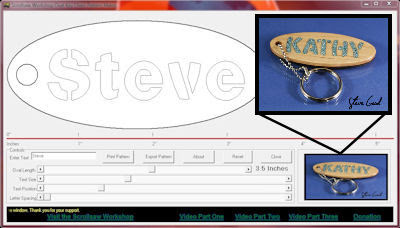If you have ever worked for a large corporation you will probably recognize what I am trying to say with this pattern.
I bet you have heard that......
"You have been empowered to make decisions." Gee thanks.
"We want you to brainstorm as a group and come up with a plan that you all agree on." Yea right!
" Sit down and come up with an action plan." That has zero cost associated with it.
"We have an open door policy." Is that the same door that hits you in the butt.
"We are a customer-centric organization." Who tracks profits to the nearest .0001 cents.
"This project is mission critical but we don't have any money to fund it. Get it done." Yesterday.
"You have been downsized but we will give you two hours of job training so you can move up in your next career." Thanks, I can't wait. I'm sure it's swell training.
I'm only this cynical on days that end in Y.
Have I ever told you how happy I am to be retired? It's been over two years and the hair still stands up on my neck when I hear these words.
Man Vs Laser. The Showdown!
Okay, this is silly but it should be fun. Recently I wrote a post talking about cutting outside the line, on the line and inside the line. If you are just getting started on the scroll saw or are only a casual scroller these techniques might sound difficult. I often hear "I can't stay on the pattern line with the blade. What am I doing wrong?". I'll answer that question below but first I want to encourage you that it is possible to be very accurate on the scroll saw.
Laser cutters are very accurate tools. What better way to test how accurate we can be than by challenging a laser. I'll give it a shot.
I designed a simple pattern for the test. We have a 2.5-inch diameter circle. The circle is intersected at various point by a straight line. I will cut the circle and the laser will cut the circle. I will use a digital micrometer to measure the diameter at the five points of the test pattern. Let's see who wins. What is your guess?
I understand that the results of this test are dependant on how accurately I can measure. I will try to be as accurate as possible but I would probably need to do the test several times for it to be totally valid. I'm not really concerned with it being totally valid. This is just for fun and to make a point.
In the test, I will try to cut on the line. That is how the laser will cut the patterns so I think that will give the best results. Here we go.
Here is the pattern. I will cut 1/4" Baltic birch plywood. That gives me the best chance to be accurate.
I will be cutting the test on my Seyco ST-21 scroll saw. It is a very accurate cutting machine. I am using a #5 Pegas modified geometry blade.
You may be able to see that I have cut away the pattern line. I went slower than normal trying to be accurate. It took about two minutes. It looks pretty round to me. It's time to take some measurements.
Test point A. 2.4880
Test point B. 2.4865
Test point C. 2.4870
Test point D. 2.4930
Test point E. 2.4900
The average Delta of my five test measurements is .0093 of an inch. I think I have a chance.
Now it's the Laser's turn. This is a Full Spectrum H-Series hobby laser. If you are interested in buying a laser shoot me an email and I can tell you about this Full Spectrum Laser. I am pretty pleased with it.
Same test pattern. The outside circle cut took about 20 seconds. It is cutting 1/8" Baltic birch plywood. It is definitely faster than me.
Dang, that looks pretty round. What do you think? Am I even close. Let's see.
Test point A. 2.4860
Test point B. 2.4845
Test point C. 2.4875
Test point D. 2.4845
Test point E 2.4855
The average Delta of the lasers five test measurements is .0144 of an inch.
I was able to beat the laser average by .0051 of an inch. That is effectively a tie for all practical purposes.
Does this prove anything? Probably not. What would happen if the pattern took 2 hours to cut? Would my accuracy fade? Yes, it would. Would the accuracy of the laser fade. Nope. The laser is not going to get tired.
What I think this silly test does show is that we can be very accurate with the scroll saw when it is required. Accuracy is not always the desired result. Inaccuracy can give a project a hand-made look that can not be easily matched with digital tools. That hand-made look has an appeal in some cases.
There are times when you do want to be accurate. If you are cutting slot and tab joints you want them to be accurate for a good fit. If you are cutting round wheels for a toy car you want them to be round so they roll. You get the point.
Click image to enlarge.
The laser cut circle on top of the scroll saw cut circle. You can see that the edges are lined up practically perfect. Other than the burnt edges do you think you would be able to tell which was man cut and which was laser cut?
Let's talk about how you can gain accuracy and what might get in your way.
The obvious answer is practice. That is true, we need to practice but you will find that accuracy can come quicker than you thought.
Yes, the saw you use will make some difference. Not as much as you might think though. As long as you can get the vibrations down to a reasonable level and set proper blade tension you can cut with accuracy on most saws.
Weight is your friend when it comes to vibration. If the saw is inexpensive it probably won't have much weight. To overcome the lack of weight make sure the saw is bolted down to a heavy surface.
The blade you use will have an impact on accuracy. Cheap blades are not worth using. You will waste more expensive wood than you will save on cheap blades. The good news is that good blades are not any more expensive than cheap blades most times.
A dull blade will make you force the blade through the wood. This will absolutely kill your accuracy. Start with a sharp blade and replace the blade before it gets dull.
A poorly tensioned blade will not cut accurately. It is very common to see scrollers under tension a scroll saw blade. If your accuracy is not where you want it then try a little more tension. I hear people say they are worried they will break the blade if they over tension it. Scroll saw blades are designed to work under high tension. They are very strong in the north and south direction. If you are breaking lots of blades it's probably not the tension.
The wood you are using can have a big impact on accuracy. You will notice that I chose Baltic birch plywood for the test. BB ply has no grain. There are no soft spots to worry about. Some woods have very pronounced open grain. Red Oak is a good example. The blade will try to follow the grain. I rarely use Red Oak. It is one of the worst woods to cut accurately.
Softwoods like pine can also cause trouble. There will be soft pockets in the board. When the blade hits that soft area it will take off on you and that is not good for accuracy. At the opposite extreme are very hard woods like Ipe. It's like cutting steel. It's so hard that you literally have to push the blade through the board. Not good. Woods like walnut, cherry, soft maple are good for cutting on the scroll saw. There are many so you have to find your favorites.
You have to learn how your saw cuts. Depending on the blade you are using you may have to compensate for blade drift. This is common on the scroll saw. There are some blades that minimize drift but its a technique you just have to practice. I usually recommend that you move your body slightly to the right of the blade. When you do that you will be pushing the wood directly away from your body and with the drift.
Relax. relax, relax. You cannot cut accurately if you are tense. Watch your hands. They should be relaxed. If your knuckles are turning white that is not relaxed. Most of the time when you are cutting it takes almost no pressure to hold the board to the table. Learn to know when you have to hold tighter and when you can relax. During a tight turn, hold a little tighter then relax after you come out of the turn.
Warm up before you start a critical project. Cut for five minutes using the same wood as the project if possible. If I am away from my saw for more than a couple of days I get rusty. I warm up.
Make a few test patterns and practice cutting on the line, outside the line, and inside the line. Here are my goals for these cuts.
If I am cutting outside the line I don't want to see white larger than the thickness of the blade. The same is true for inside the line. For slot and tab joints you actually want to be even closer than this goal. I can't get a tight fit slot and tab joint with accuracy alone. I try to undercut a little then sneak up on the fit with the blade or file. If I cut five slot and tab joints I will probably have one or two that need adjusting. After all, we are not lasers. Oh, wait....... I beat that laser.


$12 per sheet of 12 coins plus $3.50 shipping
Inlay with a 1" Forstner Bit.
The perfect way to sign your work.

Email Newsletter Readers: Remember that the Newsletter is just a copy of the daily blog post. To see the post in it's proper formatting click this link. If you ever misplace a pattern or any item you see here you can always find it on the blog. Everything stays on the blog forever.
Scroll Saw Pattern Design Tutorial: DVD
Let me teach you to create a beautiful wooden portrait pattern. I will show you everything you need from start to finish. The video will show you the free software program you can download for Windows or Mac OS. I will show you how to install the program and configure it for best results.
Let me teach you to create a beautiful wooden portrait pattern. I will show you everything you need from start to finish. The video will show you the free software program you can download for Windows or Mac OS. I will show you how to install the program and configure it for best results.
Then I will show you the technique to take your photograph and make a pattern from it. When the pattern is complete we will go in the shop and cut it.
The DVD is $10 plus shipping. This is a data DVD that you will use on your computer to watch the video tutorial
Every Scrollsaw Workshop Pattern from 2007-2017 in DVD
Purchase the entire Scrollsaw Workshop pattern catalog for offline access.
This DVD has 2,300 patterns published from 2007 thru 2017.
The DVD is $20 plus shipping. Ships to 60 countries around the world.
The DVD is $20 plus shipping. Ships to 60 countries around the world.
If you use the DVD on a Windows PC there is a simple viewer program to browse through the patterns.
The DVD also works fine on a MAC. The viewer program is not MAC compatible but there is an included PDF with all the patterns shown as thumbnails for easy viewing.
My two "Wooden Vases on the Scroll Saw" books make it easy.
The books are $12 each and available for instant download after purchase. Click for Video Demonstration.
My Sponsors:
Support the businesses who support our community.
Home of Pegas scroll saw blades.
 Ad: Affiliate
Ad: Affiliate4" Sanding Mop, 220 Grit
I hate buying sanding mops because they are so expensive. I love buying sanding mops because I can't live without them. You will have sticker shock when you click this link. Yes, they are expensive. The good news is that they last a long time.
I find sanding mops the best tool for sanding away fuzzies on the back of delicate fretwork cuts. I back the piece up with my hand and lightly run it over the mop. You have to be careful but it is pretty delicate and I rarely break the fretwork. This mop won't remove a lot of material. It's not made for that. It does do a nice job of breaking sharp edges of irregular shaped projects. You can install the mop in a drill press but I find it works best in a stationary grinder. I prefer the mop to be vertical.
- 4" Diameter, 1/4" Shaft
- Great for sanding irregularly shapped projects
- Long lasting cloth backed sandpaper
- 220 Grit





















































